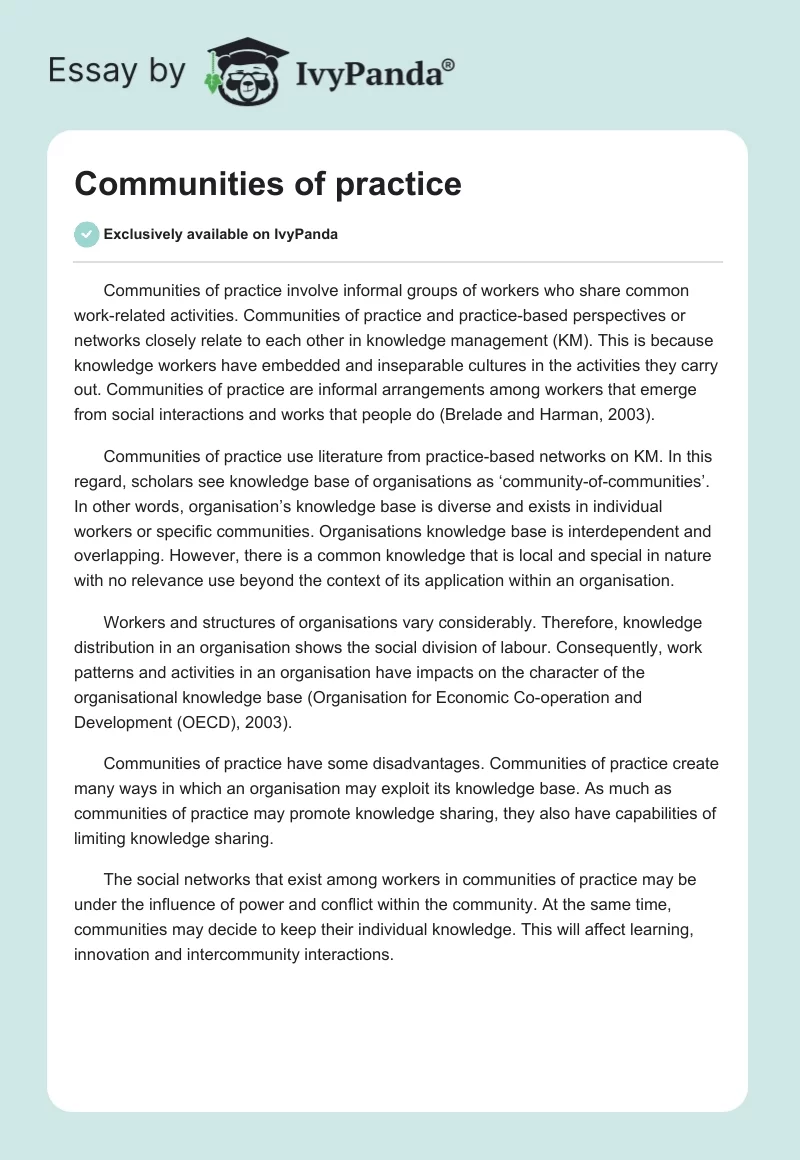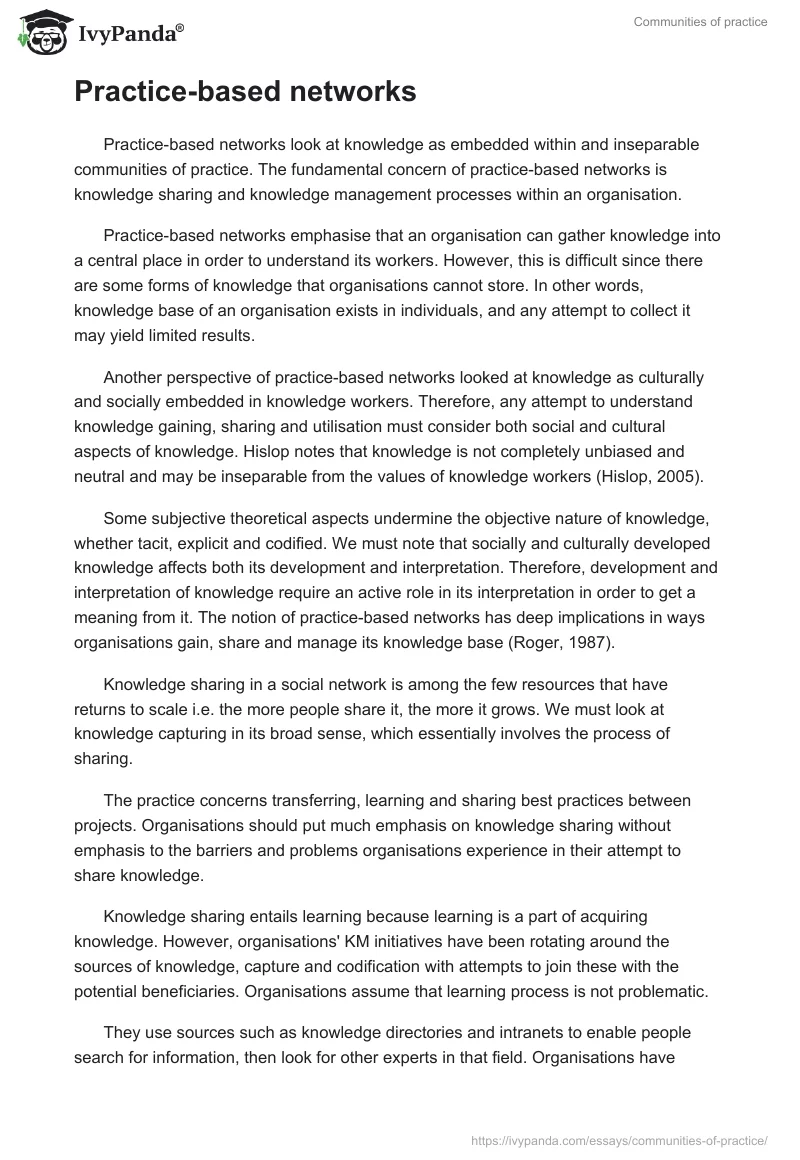Communities of practice involve informal groups of workers who share common work-related activities. Communities of practice and practice-based perspectives or networks closely relate to each other in knowledge management (KM). This is because knowledge workers have embedded and inseparable cultures in the activities they carry out. Communities of practice are informal arrangements among workers that emerge from social interactions and works that people do (Brelade and Harman, 2003).
Communities of practice use literature from practice-based networks on KM. In this regard, scholars see knowledge base of organisations as ‘community-of-communities’. In other words, organisation’s knowledge base is diverse and exists in individual workers or specific communities. Organisations knowledge base is interdependent and overlapping. However, there is a common knowledge that is local and special in nature with no relevance use beyond the context of its application within an organisation.
Workers and structures of organisations vary considerably. Therefore, knowledge distribution in an organisation shows the social division of labour. Consequently, work patterns and activities in an organisation have impacts on the character of the organisational knowledge base (Organisation for Economic Co-operation and Development (OECD), 2003).
Communities of practice have some disadvantages. Communities of practice create many ways in which an organisation may exploit its knowledge base. As much as communities of practice may promote knowledge sharing, they also have capabilities of limiting knowledge sharing.
The social networks that exist among workers in communities of practice may be under the influence of power and conflict within the community. At the same time, communities may decide to keep their individual knowledge. This will affect learning, innovation and intercommunity interactions.
Practice-based networks
Practice-based networks look at knowledge as embedded within and inseparable communities of practice. The fundamental concern of practice-based networks is knowledge sharing and knowledge management processes within an organisation.
Practice-based networks emphasise that an organisation can gather knowledge into a central place in order to understand its workers. However, this is difficult since there are some forms of knowledge that organisations cannot store. In other words, knowledge base of an organisation exists in individuals, and any attempt to collect it may yield limited results.
Another perspective of practice-based networks looked at knowledge as culturally and socially embedded in knowledge workers. Therefore, any attempt to understand knowledge gaining, sharing and utilisation must consider both social and cultural aspects of knowledge. Hislop notes that knowledge is not completely unbiased and neutral and may be inseparable from the values of knowledge workers (Hislop, 2005).
Some subjective theoretical aspects undermine the objective nature of knowledge, whether tacit, explicit and codified. We must note that socially and culturally developed knowledge affects both its development and interpretation. Therefore, development and interpretation of knowledge require an active role in its interpretation in order to get a meaning from it. The notion of practice-based networks has deep implications in ways organisations gain, share and manage its knowledge base (Roger, 1987).
Knowledge sharing in a social network is among the few resources that have returns to scale i.e. the more people share it, the more it grows. We must look at knowledge capturing in its broad sense, which essentially involves the process of sharing.
The practice concerns transferring, learning and sharing best practices between projects. Organisations should put much emphasis on knowledge sharing without emphasis to the barriers and problems organisations experience in their attempt to share knowledge.
Knowledge sharing entails learning because learning is a part of acquiring knowledge. However, organisations’ KM initiatives have been rotating around the sources of knowledge, capture and codification with attempts to join these with the potential beneficiaries. Organisations assume that learning process is not problematic.
They use sources such as knowledge directories and intranets to enable people search for information, then look for other experts in that field. Organisations have recognised that effective knowledge sharing lies with the natural, human processes and preferences for communication. This is because knowledge sharing is about people and not technology.
The first thing people normally do when looking for information is to ask a workmate. Therefore, knowledge sharing initiatives should embrace natural, human processes in social networks.
Organisations are introducing incentives for knowledge sharing. For instance, Lotus Development gives 25 per cent of its overall performance evaluation point among its customer service team for knowledge sharing.
Some organisations such as the UK Defence Evaluation and Research Agency (DERA) use financial incentives as bonuses and rewards to persuade staffs who do not post information on the knowledge sharing system. In this context, companies must work hard to improve a culture of support, fairness, trust and reciprocity required so as to embrace knowledge sharing. Most organisations seek to identify and embed best practices in knowledge sharing.
Challenges organizations may face when participating in social networks
There were evidences that most management teams rarely used the computer-based information to make crucial decisions. This was because IT systems were not capturing information they needed. Managers preferred face-to-face or telephone talks and got other parts of information from outside documents.
Most companies have been using IT systems to share knowledge. However, most forms of human knowledge cannot be coded. This information remains inaccessible to IT systems (Tidd, 2006).
The fact that knowledge is available does not mean people are sharing it. Social network systems have enormous potential to support communication and exchange of information, and there is vast information available on the internet.
However, organisations, which have adopted the use of social networks to drive their KM initiatives, must align it with their strategies and other factors. Social network initiatives require the enthusiastic co-operation and input of all staff within a culture of support. Culture of secrecy, internal competition and lack of trust must change so as to drive learning and innovation initiatives.
Significant lessons for any organisation adopting KM initiatives using technology are the supportive role of IT in driving practices. IT systems can only deal with knowledge only if it can be coded and represented in the systems (Davenport and Prusack, 1997). However, tacit, experiential knowledge is not part of codified knowledge.
Occasionally, social, cultural, structural barriers and process issues hinder the developments and contributions of IT to any practice initiative.
Effective use of social network systems to better manage knowledge in an organisation should focus on connectivity i.e. providing communications channels that connect human together instead of capturing and representing human knowledge. In addition, organisations must also create an environment where co-workers feel free to share ideas, opinions and knowledge.
KM starting point recognises where organisations can derive immediate value. This serves to win the core business cases of the firm. Organisation’s practice in a knowledge economy stresses the point to embrace new ways of working enhanced by the internet. Learning and innovation create an enabling environment whereby organisations have realised improved service delivery, reduced time of generating new products and improved productivity of the use of a large number of collaborative work force (Drucker, 1994).
Collaboration in a knowledge economy is cutting across the organisation’s boundaries in including the partners, suppliers, and even consumers. A knowledge-driven economy values the recruitment and retention of the knowledge workers (Jennex, 2009). Talent search is now beyond salary packages.
It has shifted to alignment of the individual’s values, abilities, interests to produce meaningful work and accommodate the lifestyle choice of the individual knowledge worker.
It is necessary to note that the role and position of knowledge worker is becoming crucial and even challenging the role of managers. The role of management is changing to supporting and facilitating the works of staff rather than regulating their conducts (Storey, 1993).
Organisation’s learning and innovation cannot possibly happen in an environment which lacks a supportive and flexible organisational structure. Creativity, innovation and application of knowledge cannot thrive in highly regulated environment. This is because these ingredients to KM require trust and collaboration. Organisations which lack of trust, recognition, and collaboration drag down the steps to KM initiatives.
It is vital to note that learning and innovation are not linear subjects. Knowledge itself is difficult to define. Therefore, effective learning and innovation should be flexible enough to accommodate all forms of knowledge a knowledge worker possesses. The question of information sharing and breaking down the barriers created by organisational politics is also a vital lesson for companies planning to embrace KM in its operations (Tiwana, 1999).
Reference List
Brelade, S. and Harman, C., 2003. A Practical Guide to Knowledge Management. London: Thorogood.
Davenport, T. and Prusack, L., 1997. Working Knowledge – How organisations manage what they know. Boston, MA: Harvard Business School.
Drucker, P., 1994. Innovation and Entrepreneurship. London: Butterworth Heinemann.
Hislop, D., 2005. knowledge management in organizations: A critical introduction. Oxford: Oxford University Press Inc.
Jennex, M., 2009. Knowledge Management, Organizational Memory, and Transfer Behavior: Global Approaches and Advancements. London: Information Science Reference.
Organisation for Economic Co-operation and Development (OECD)., 2003. Measuring Knowledge Management in the Business Sector: First Steps. Paris: OECD Publications Service.
Roger, H., 1987. Organisational Culture and Quality of Service. London: AMED Publishing.
Storey, J., 1993. New perspectives on Human Resource Management. New York: Routledge.
Tidd, J., 2006. From Knowledge Management to Strategic Competence: Measuring Technological, Market and Organisational Innovation. London: Imperial College Press.
Tiwana, A., 1999. The Knowledge Management Toolkit. New York: Prentice Hall.


